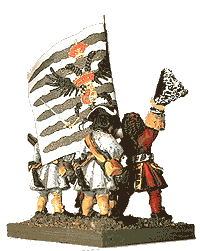The Swabian League was an association of German cities, principalities and knights principally in the territory which had formed the old duchy of Swabia. The name is not applicable to several earlier leagues (e.g. those of 1331, 1376), since those leagues were City Leagues only. Their intention being a defensive league against the principalities, mainly Württemberg and the knights. Whereas in The Swabian League these former adverseries cooperated towards new ends: The keeping of the imperial peace and at least in the beginning curbing the expansionist Bavarian dukes.
The Swabian cities had attained great prosperity under the protection of the Hohenstaufen emperors, but the extinction of that house in 1268 was followed by disintegration. Cities and nobles alike, now owing allegiance to none but the emperor, who was seldom able to defend them, were exposed to the aggression of ambitious princes.
In 1331, 22 Swabian cities, including Ulm, Augsburg, Reutlingen and Heilbronn, formed a league at the instance of Emperor Louis the Bavarian, who in return for their support promised not to mortgage any of them to a vassal. The count of Württemberg was induced to join in 1340. Under Charles IV, the lesser Swabian nobles began to combine against the cities, and formed the Schleglerbund (from Schlegel, a maul). Civil war ensuing in 1367, the emperor, jealous of the growing power of the cities, endeavoured to set up a league under his own control, for the maintenance of public peace (Landfriedensbund, 1370). The defeat of the city league by Eberhard II of Württemberg in 1372, the murder of the captain of the league, and the breach of his obligations by Charles IV, led to the formation of a new league of fourteen Swabian cities led by Ulm in 1376. This league triumphed over the count of Württemberg at Reutlingen in 1377, and the emperor having removed his ban, it set up an arbitration court, and was rapidly extended over the Rhineland, Bavaria, and Franconia. However, Württemberg struck back and defeated the league in 1388.
In 1488 a new Swabian league was formed, at Esslingen, not only of 22 imperial cities but also of the Swabian knights' League of St. George's Shield, bishops, and princes (Ansbach, Baden, Bavaria, Bayreuth, Hesse, Mainz, the Palatinate, Trier, Tyrol, and Württemberg). The league was governed by a federal council of three colleges of princes, cities, and knights calling upon an army of 13,000 men. It aided in the rescue of the future emperor Maximilian I, Frederick III's son, held prisoner in the Low Countries, and later was his main support in southern Germany. In 1519, the League conquered Württemberg and sold it to Charles V after its count Ulrich attempted to seize the city of Reutlingen. It helped to suppress the Peasants' Revolt (1524–25). The Reformation caused the league to be disbanded in 1534.

 Lefthit
Lefthit
No comments:
Post a Comment